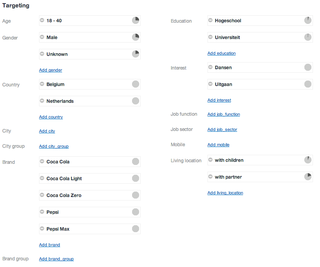Related Research Articles

Privacy is the ability of an individual or group to seclude themselves or information about themselves, and thereby express themselves selectively.

An online community, also called an internet community or web community, is a community whose members interact with each other primarily via the Internet. Members of the community usually share common interests. For many, online communities may feel like home, consisting of a "family of invisible friends". Additionally, these "friends" can be connected through gaming communities and gaming companies. Those who wish to be a part of an online community usually have to become a member via a specific site and just to specific content or links.
Internet privacy involves the right or mandate of personal privacy concerning the storage, re-purposing, provision to third parties, and display of information pertaining to oneself via the Internet. Internet privacy is a subset of data privacy . Privacy concerns have been articulated from the beginnings of large-scale computer sharing and especially relate to mass surveillance.

Social media are interactive technologies that facilitate the creation, sharing and aggregation of content amongst virtual communities and networks. Common features include:

Facebook is a social media and social networking service owned by the American technology conglomerate Meta. Created in 2004 by Mark Zuckerberg with four other Harvard College students and roommates Eduardo Saverin, Andrew McCollum, Dustin Moskovitz, and Chris Hughes, its name derives from the face book directories often given to American university students. Membership was initially limited to Harvard students, gradually expanding to other North American universities. Since 2006, Facebook allows everyone to register from 13 years old, except in the case of a handful of nations, where the age requirement is 14 years. As of December 2023, Facebook claimed almost 3.07 billion monthly active users worldwide. As of November 2024, Facebook ranked as the third-most-visited website in the world, with 23% of its traffic coming from the United States. It was the most downloaded mobile app of the 2010s.

Social information processing theory, also known as SIP, is a psychological and sociological theory originally developed by Salancik and Pfeffer in 1978. This theory explores how individuals make decisions and form attitudes in a social context, often focusing on the workplace. It suggests that people rely heavily on the social information available to them in their environments, including input from colleagues and peers, to shape their attitudes, behaviors, and perceptions.

Digital footprint or digital shadow refers to one's unique set of traceable digital activities, actions, contributions, and communications manifested on the Internet or digital devices. Digital footprints can be classified as either passive or active. The former is composed of a user's web-browsing activity and information stored as cookies. The latter is often released deliberately by a user to share information on websites or social media. While the term usually applies to a person, a digital footprint can also refer to a business, organization or corporation.

Targetedadvertising or data-driven marketing is a form of advertising, including online advertising, that is directed towards an audience with certain traits, based on the product or person the advertiser is promoting.

Men and women use social network services (SNSs) differently and with different frequencies. In general, several researchers have found that women tend to use SNSs more than men and for different and more social purposes.
Communication privacy management (CPM), originally known as communication boundary management, is a systematic research theory developed by Sandra Petronio in 1991. CPM theory aims to develop an evidence-based understanding of the way people make decisions about revealing and concealing private information. It suggests that individuals maintain and coordinate privacy boundaries with various communication partners depending on the perceived benefits and costs of information disclosure. Petronio believes disclosing private information will strengthen one's connections with others, and that we can better understand the rules for disclosure in relationships through negotiating privacy boundaries.

Digital privacy is often used in contexts that promote advocacy on behalf of individual and consumer privacy rights in e-services and is typically used in opposition to the business practices of many e-marketers, businesses, and companies to collect and use such information and data. Digital privacy, a crucial aspect of modern online interactions and services, can be defined under three sub-related categories: information privacy, communication privacy, and individual privacy.
Since the arrival of early social networking sites in the early 2000s, online social networking platforms have expanded exponentially, with the biggest names in social media in the mid-2010s being Facebook, Instagram, Twitter and Snapchat. The massive influx of personal information that has become available online and stored in the cloud has put user privacy at the forefront of discussion regarding the database's ability to safely store such personal information. The extent to which users and social media platform administrators can access user profiles has become a new topic of ethical consideration, and the legality, awareness, and boundaries of subsequent privacy violations are critical concerns in advance of the technological age.
Social media intelligence comprises the collective tools and solutions that allow organizations to analyze conversations, respond to synchronize social signals, and synthesize social data points into meaningful trends and analysis, based on the user's needs. Social media intelligence allows one to utilize intelligence gathering from social media sites, using both intrusive or non-intrusive means, from open and closed social networks. This type of intelligence gathering is one element of OSINT.
Google's changes to its privacy policy on March 16, 2012, enabled the company to share data across a wide variety of services. These embedded services include millions of third-party websites that use AdSense and Analytics. The policy was widely criticized for creating an environment that discourages Internet innovation by making Internet users more fearful and wary of what they do online.
In the 2010s, personal data belonging to millions of Facebook users was collected by British consulting firm Cambridge Analytica for political advertising, without having the informed consent of users for that purpose.
Privacy settings are the part of a social networking website, web browser, or other piece of software, that allows a user to control who sees information about the user. With the growing prevalence of social networking services, opportunities for privacy exposures also grow. Privacy settings allow a person to control what information is shared on these platforms.
The advent of social networking services has led to many issues spanning from misinformation and disinformation to privacy concerns related to public and private personal data.
Meta Platforms Inc., or Meta for short, has faced a number of privacy concerns. These stem partly from the company's revenue model that involves selling information collected about its users for many things including advertisement targeting. Meta Platforms Inc. has also been a part of many data breaches that have occurred within the company. These issues and others are further described including user data concerns, vulnerabilities in the company's platform, investigations by pressure groups and government agencies, and even issues with students. In addition, employers and other organizations/individuals have been known to use Meta Platforms Inc. for their own purposes. As a result, individuals’ identities and private information have sometimes been compromised without their permission. In response to these growing privacy concerns, some pressure groups and government agencies have increasingly asserted the users’ right to privacy and to be able to control their personal data.
Soft privacy technologies fall under the category of PETs, Privacy-enhancing technologies, as methods of protecting data. Soft privacy is a counterpart to another subcategory of PETs, called hard privacy. Soft privacy technology has the goal of keeping information safe, allowing services to process data while having full control of how data is being used. To accomplish this, soft privacy emphasizes the use of third-party programs to protect privacy, emphasizing auditing, certification, consent, access control, encryption, and differential privacy. Since evolving technologies like the internet, machine learning, and big data are being applied to many long-standing fields, we now need to process billions of datapoints every day in areas such as health care, autonomous cars, smart cards, social media, and more. Many of these fields rely on soft privacy technologies when they handle data.

Jessica Vitak is an American information scientist who is an associate professor at the University of Maryland. She is faculty in the University of Maryland College of Information Studies (iSchool) and Communication Department. She serves as Director of the University of Maryland Human–Computer Interaction Lab (HCIL) and an Associate Member of the Social Data Science Center (SoDa).
References
- ↑ Garcia, David (August 2017). "Leaking privacy and shadow profiles in online social networks". Science Advances. 3 (8): e1701172. Bibcode:2017SciA....3E1172G. doi:10.1126/sciadv.1701172. ISSN 2375-2548. PMC 5544396 . PMID 28798961.
- ↑ Brandom, Russell (11 April 2018). "Shadow profiles are the biggest flaw in Facebook's privacy defense". The Verge. Retrieved 29 October 2023.
- ↑ Debatin, Bernhard; Lovejoy, Jennette P.; Horn, Ann-Kathrin; Hughes, Brittany N. (October 2009). "Facebook and Online Privacy: Attitudes, Behaviors, and Unintended Consequences". Journal of Computer-Mediated Communication. 15 (1): 83–108. doi: 10.1111/j.1083-6101.2009.01494.x . ISSN 1083-6101.
- ↑ Newton, Casey (April 12, 2018). "The data Facebook collects without permission". The Interface (Newsletter). Vox Media. Archived from the original on October 6, 2021. Retrieved November 12, 2020– via Revue.